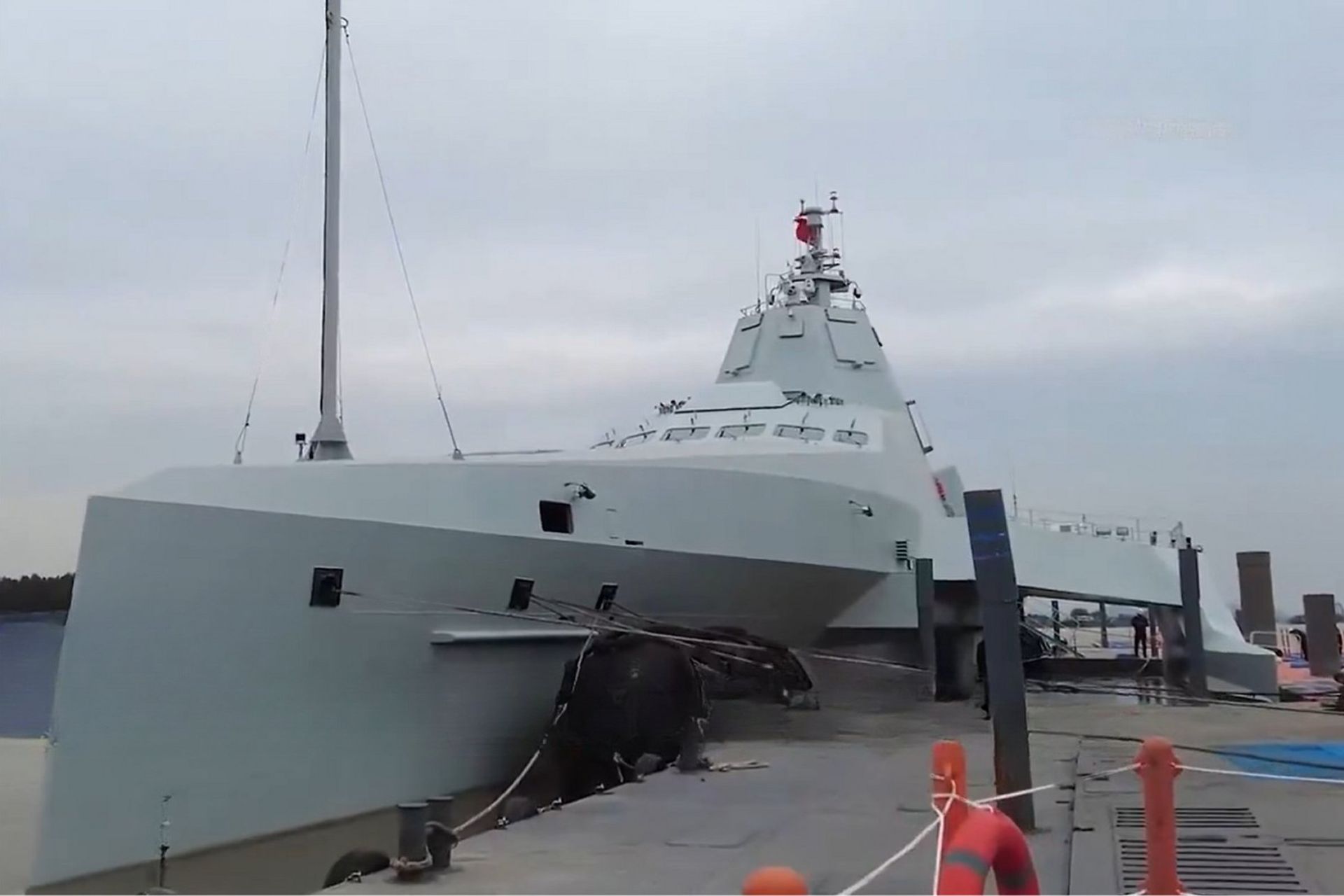Breaking News
China’s JARI USV A Orca Unmanned Vessel with VLS revealed at Zhuhai.
The JARI-USV-A "Orca," a large unmanned surface combat vessel developed by China State Shipbuilding Corporation (CSSC), has arrived in Zhuhai’s Doumen Lianzhou on November 8 to participate in the 15th Zhuhai Airshow. Known for its trimaran design and stealth capabilities, this vessel is attracting widespread attention.
Follow Army Recognition on Google News at this link

China's JARI-USV-A 'Orca,' an advanced unmanned surface vessel, debuts at the 15th Zhuhai Airshow, showcasing its stealth trimaran design, powerful AESA radar, and versatile combat capabilities, poised for both coastal defense and international markets. (Picture source: Chinese TV)
With a length of 58 meters, a beam width of 23 meters, a beam depth of 4 meters, and a draft of 2 meters, the JARI-USV-A "Orca" can operate at speeds up to 40 knots with a range of 4,000 nautical miles, optimized for long-endurance missions. Its unique trimaran hull provides excellent wave-resistance and stability, enhancing its suitability for near-shore defense or extended deployment as a forward “picket ship” hundreds of kilometers from the main fleet.
Built with stealth as a priority, the JARI-USV-A is highly radar-resistant, significantly reducing its detectability. The vessel's combat bridge houses a large four-cell Vertical Launch System (VLS) with an 850mm diameter, identified as the HT-1 universal VLS, allowing for hot or cold launch configurations in line with the Chinese Navy's shipborne standards. Additionally, an open area in front of the VLS is reserved for potential customizations to accommodate additional VLS units, such as the H/AKJ16 650mm vertical launcher, depending on client needs.
The Orca also integrates an advanced "S-band + X-band" AESA radar system with conformal antenna technology for communication, electronic warfare, and data link operations, as well as infrared and electro-optical sensors for extensive situational awareness. Its AESA radar, multi-panel antenna system, and robust electronic suite grant it the operational awareness necessary for anti-ship, anti-air, and anti-submarine roles.
The JARI-USV-A’s compact design incorporates sophisticated technologies seen in the larger Type 055 destroyer, such as an integrated radio frequency system with phased array radar. Its aft deck features a take-off and landing platform for unmanned helicopters, providing enhanced surveillance and strike capabilities. Additionally, the stern features a large opening, which allows the option for CSSC to install both active and passive towed sonar arrays for submarine detection, giving it anti-submarine and naval strike capabilities.
The JARI-USV-A’s stealth and modular design reflect CSSC’s ambition to target export markets, particularly in regions like the Middle East. The vessel sailed from a shipyard in Guangzhou to the newly established "Unmanned Vessel Demonstration Zone" at the Zhuhai Airshow, a first in the event’s history. This waterfront zone will host dynamic demonstrations and a static display area, showcasing advanced unmanned vessels.
Comparison
The JARI-USV-A "Orca," developed by China State Shipbuilding Corporation (CSSC), exemplifies a new wave of unmanned, stealth-optimized trimaran vessels, comparable to other notable trimaran designs used in modern naval forces. Although much smaller in displacement than the U.S. Navy’s Independence-class Littoral Combat Ships (LCS) and the Royal Navy's experimental RV Triton, it represents a focused shift toward autonomous maritime capabilities.
The Orca operates at speeds of up to 40 knots and has a range of over 4,000 nautical miles, allowing for prolonged missions without resupply—a trait it shares with the larger Independence-class LCS. This class, designed for high-speed littoral missions, is notably larger, measuring 127 meters in length, with advanced waterjet propulsion systems driving it to speeds also exceeding 40 knots. The RV Triton, used as a technology demonstrator, played a significant role in proving the trimaran’s efficacy in various sea conditions, influencing subsequent designs.
In terms of combat capability, the Orca is equipped with an AESA radar and a Vertical Launch System (VLS), providing multi-domain engagement capacity through anti-ship, anti-air, and anti-submarine capabilities. Its design also includes a rear deck for unmanned helicopter operations, enhancing its surveillance reach. While smaller and entirely autonomous, the Orca integrates many features typical of larger manned combatants like the Independence-class LCS, which houses a 57 mm gun, SeaRAM missile defense, and supports mission-specific modules. This allows the LCS to pivot between tasks like anti-submarine warfare (ASW), mine countermeasures, and surface warfare, backed by helicopter and UAV support. The RV Triton, although not armed, tested many of these technologies, demonstrating the trimaran hull’s flexibility and informing later designs in stealth and modular capability.
The Orca’s distinct role as an unmanned platform highlights its purpose for operations in hazardous zones, minimizing human risk while enabling persistent, adaptable presence in high-stakes environments. In contrast, the manned Independence-class LCS leverages modular adaptability for versatility across various mission types, while the RV Triton remains a vital precursor in demonstrating the potential of trimaran warships.



























